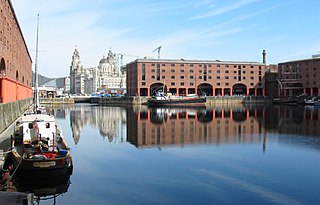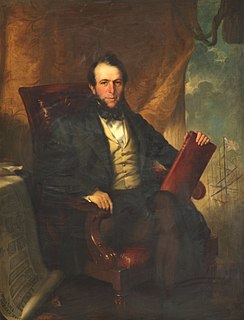
Liverpool is a city and metropolitan borough in Merseyside, England. As of 2018, the population is approximately 494,814. Liverpool is the ninth-largest English district by population, and the largest in Merseyside and the Liverpool City Region. It lies within the United Kingdom's sixth-most populous urban area. Liverpool's metropolitan area is the fifth-largest in the United Kingdom, with a population of 2.24 million.

Philip Hardwick was an English architect, particularly associated with railway stations and warehouses in London and elsewhere. Hardwick is probably best known for London's demolished Euston Arch and its twin station, the original Birmingham Curzon Street, which stands today as the oldest railway terminus building in the world.

The Royal Albert Dock is a complex of dock buildings and warehouses in Liverpool, England. Designed by Jesse Hartley and Philip Hardwick, it was opened in 1846, and was the first structure in Britain to be built from cast iron, brick and stone, with no structural wood. As a result, it was the first non-combustible warehouse system in the world. It was known as the Albert Dock until 2018, when it was granted a royal charter and had the honorific "Royal" added to its name.

Salthouse Dock is a dock on the River Mersey, England, and part of the Port of Liverpool. It is situated in the southern dock system, connected to Canning Dock to the north, Wapping Dock via Wapping Basin to the south and Albert Dock to the west.

Wapping Dock is a dock on the River Mersey, England, and part of the Port of Liverpool. It is situated in the southern dock system, connected to Salthouse Dock to the north, Queen's Dock to the south. King's Dock was originally located to the west, but has since been filled in.

Brunswick Dock is a dock on the River Mersey, in England, and part of the Port of Liverpool. It is situated in the southern dock system, connected to Coburg Dock to the north, Toxteth Dock to the south.

Canning Half Tide Dock on the River Mersey, in Liverpool, England, is a half tide dock and is part of the Port of Liverpool. It is situated in the southern dock system, connected to Canning Dock to the east and Albert Dock to the south.
King's Dock was a dock on the River Mersey in England and part of the Port of Liverpool. It was situated in the southern dock system, connected to Wapping Dock to the north and Queen's Dock to the south. It consisted of two branch docks.
Victoria Dock may refer to:

The Royal Albert Dock is one of three docks in the Royal Group of Docks of East London in the United Kingdom, now undergoing major redevelopment.

The Hospital for Tropical Diseases (HTD) is a specialist tropical disease hospital located in London, United Kingdom. It is part of the University College London Hospitals NHS Foundation Trust and is closely associated with University College London and the London School of Hygiene & Tropical Medicine. It is the only NHS hospital dedicated to the prevention, diagnosis and treatment of tropical diseases and travel-related infections. In addition it employs specialists in major tropical diseases such as malaria, leprosy and tuberculosis. It also provides an infectious disease treatment service for University College Hospital.
Royal Albert may refer to several places named in memory of Prince Albert of Saxe-Coburg and Gotha:

The Port of Hull is a port at the confluence of the River Hull and the Humber Estuary in Kingston upon Hull, East Riding of Yorkshire, England.
Edward Horton Hubbard was an English architectural historian who worked with Nikolaus Pevsner in compiling volumes of the Buildings of England. He also wrote the definitive biography of John Douglas, and played a part in the preservation of Albert Dock in Liverpool.
The British Dragon Boat Racing Association (BDA) is the UK governing body for dragon boat racing as a sport and recreation, recognised by the UK Sports Council and a Member of the Sport Alliance, Water Recreation Division.

There are over 2500 listed buildings in Liverpool, England. A listed building is one considered to be of special architectural, historical or cultural significance, which is protected from being demolished, extended or altered, unless special permission is granted by the relevant planning authorities. Of the listed buildings in Liverpool, 27 are classified as Grade I listed and are recognised as buildings of outstanding architectural or historic interest. The following list provides information on all the Grade I listed buildings in the city.
The following is a timeline of the history of the city of Liverpool, England.
The following is a timeline of the history of the city of Hull, England.

John Bramley-Moore was an English politician and chairman of Mersey Docks and Harbour Board.










